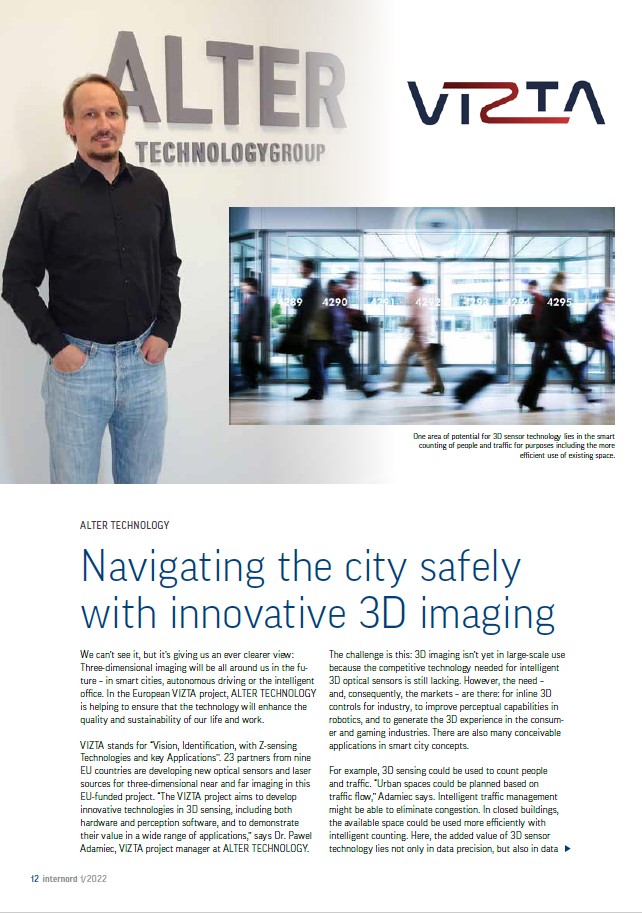We can’t see it, but it’s giving us an ever clearer view:
Three-dimensional imaging will be all around us in the future
– in smart cities, autonomous driving or the intelligent
office. In the European VIZTA project, ALTER TECHNOLOGY
is helping to ensure that the technology will enhance the
quality and sustainability of our life and work.
VIZTA stands for “Vision, Identification, with Z-sensing
Technologies and key Applications’’. 23 partners from nine
EU countries are developing new optical sensors and laser
sources for three-dimensional near and far imaging in this
EU-funded project. “The VIZTA project aims to develop
innovative technologies in 3D sensing, including both
hardware and perception software, and to demonstrate
their value in a wide range of applications,’’ says Dr. Pawel
Adamiec, VIZTA project manager at ALTER TECHNOLOGY.
The challenge is this: 3D imaging isn’t yet in large-scale use
because the competitive technology needed for intelligent
3D optical sensors is still lacking. However, the need –
and, consequently, the markets – are there: for inline 3D
controls for industry, to improve perceptual capabilities in
robotics, and to generate the 3D experience in the consumer
and gaming industries. There are also many conceivable
applications in smart city concepts.
For example, 3D sensing could be used to count people
and traffic. “Urban spaces could be planned based on
traffic flow,’’ Adamiec says. Intelligent traffic management
might be able to eliminate congestion. In closed buildings,
the available space could be used more efficiently with
intelligent counting. Here, the added value of 3D sensor
technology lies not only in data precision, but also in data
protection. People are captured anonymously in 3D images,
and actually identifying them would require in-depth analysis
using artificial intelligence.
The reliable and direct recording of the environment plays a crucial role in autonomous driving, for example. 3D imaging has not yet been widely deployed here. The sensors are complex and, above all, still very expensive. “3D sensing, although it’ll probably go unnoticed by most people, will soon be used by all the electronics, machines, cars, drones, etc. that surround us to enable them to position themselves in space and analyze their surroundings rather like we humans do,’’ Adamiec explains. What is at stake is our everyday life and a global market worth billions.
In the project, ALTER TECHNOLOGY is ensuring the safety of the products in close cooperation with the technology leaders in the industry. Among other things, ALTER is analyzing and evaluating compliance with norms, standards and regulations, taking care of usage rights and working with its partners to develop exploitation plans for the market launch and commercial use of the project results.
As a member of TÜV NORD GROUP, ALTER TECHNOLOGY has in-depth experience in the field of certification and is now a leader in its own right in the development of standards (EU CDR 2019/945, EN4709). The company has recently become the first notified body to be accredited for the conformity assessment of drones in Europe. Drones can be used for sewer inspections in smart cities, for instance. “Urban sewers are in some cases too small or too dangerous for human inspectors,’’ Adamiec says. “Using an autonomous inspection platform can reduce the risks for maintenance workers.’’ So, the focus of technological innovation is always on people and their safety.
The 3D sensor technology developed within the VIZTA project can be used to determine the position of the drone itself and, moreover, to inspect the sewer at the same time. VIZTA’s results will thus enable drones to perform even better in the future by decreasing the payload and costs.
VIZTA has deliberately brought together industry and academia to enable the demonstrators developed as part of the project to be rapidly and successfully rolled out on an industrial scale. “The demos and prototypes developed in the project are at the technological cutting edge, so it’s important to ensure that they can be commercialized without major obstacles,’’ says Adamiec. “Working with a lot of partners from industry and research to update my knowledge of 3D sensing is what makes the project so exciting for me,’’ Adamiec says. “After all, this is the technology that’s soon going to be surrounding us as we go about our everyday tasks.’’ The project will run until October 2022.
source: INTERNORD 1/2022
